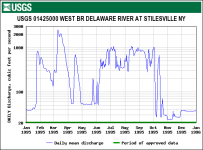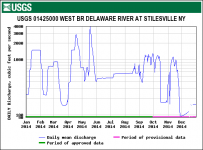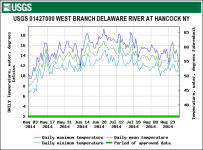JOE.T
Dry Flies Only
Here are 5 links to the USGS Stilesville Guage.
I ran 1995-1999 to give everyone an idea of what we use to have in the "Summer" -June ,July, and August for Releases on the WB.
You can see that we had a lot more water coming down the WB back than.It had nothing to do with a fisheries plan, it was all about keeping Montaque at 1750.
Than years later we started with Rio dumping water down the Mongaup and Wallenpaupack dumping water down the Lackawaxen to take care of Montaque
The reservoir would often get well below 50% capacity by September but it always filled back up, and NYC always had water to sell.
The Point is now with down river resources satisfying Montaque there is more than enough water to add to the fishery.For now will call that number X.
If you see anything above 1500 cfs that meant that we had a spill from a lot of rain.You can't debate facts like this.
1995 - USGS Current Conditions for USGS 01425000 WEST BR DELAWARE RIVER AT STILESVILLE NY
1996 - USGS Current Conditions for USGS 01425000 WEST BR DELAWARE RIVER AT STILESVILLE NY
1997 - USGS Current Conditions for USGS 01425000 WEST BR DELAWARE RIVER AT STILESVILLE NY
1998 - USGS Current Conditions for USGS 01425000 WEST BR DELAWARE RIVER AT STILESVILLE NY
1999 - USGS Current Conditions for USGS 01425000 WEST BR DELAWARE RIVER AT STILESVILLE NY
I ran 1995-1999 to give everyone an idea of what we use to have in the "Summer" -June ,July, and August for Releases on the WB.
You can see that we had a lot more water coming down the WB back than.It had nothing to do with a fisheries plan, it was all about keeping Montaque at 1750.
Than years later we started with Rio dumping water down the Mongaup and Wallenpaupack dumping water down the Lackawaxen to take care of Montaque
The reservoir would often get well below 50% capacity by September but it always filled back up, and NYC always had water to sell.
The Point is now with down river resources satisfying Montaque there is more than enough water to add to the fishery.For now will call that number X.
If you see anything above 1500 cfs that meant that we had a spill from a lot of rain.You can't debate facts like this.
1995 - USGS Current Conditions for USGS 01425000 WEST BR DELAWARE RIVER AT STILESVILLE NY
1996 - USGS Current Conditions for USGS 01425000 WEST BR DELAWARE RIVER AT STILESVILLE NY
1997 - USGS Current Conditions for USGS 01425000 WEST BR DELAWARE RIVER AT STILESVILLE NY
1998 - USGS Current Conditions for USGS 01425000 WEST BR DELAWARE RIVER AT STILESVILLE NY
1999 - USGS Current Conditions for USGS 01425000 WEST BR DELAWARE RIVER AT STILESVILLE NY




